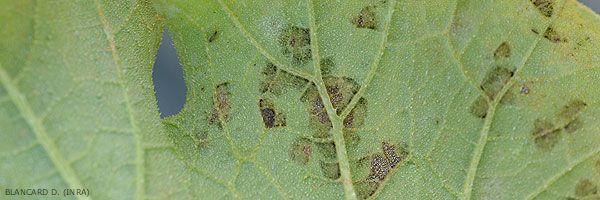
Pseudoperonospora cubensis (Berk. & M.A. Curtis) Rostovzev (1903)
Mildew
- classification : Chromista*, Oomycota, Oomycetes, Peronosporomycetidae, Peronosporales, Peronosporaceae
- synonymies : Peronoplasmopara cubensis (Berk. & M.A. Curtis) G.P. Clinton [as ' cubense '], (1905) [1904] ; Peronospora cubensis Berk. & M.A. Curtis, (1868) [1869] ; Plasmopara cubensis (Berk. & M.A. Curtis) C.J. Humphrey, (1891).
- English name: downy mildew ; Spanish name: mildiù
Pseudoperonospora cubensis has climatic requirements that allowed it to first colonize the tropics and subtropics of the globe. It is now very widely distributed in the world, on all continents and in much more northern latitudes. It is reported in North and South America (Canada, USA, Mexico, Brazil, Argentina ), Asia (China, Taiwan, North and South Korea, Indonesia, India ), Africa (Algeria, Cameroon, Senegal, Niger, Ethiopia ), in many countries in Western Europe (Italy, Spain, Germany, England ) as well as in the East (Czech Republic, Poland, Albania, Belarus, Ukraine, Moldavia, Baltic Republic, Russia ), in the Mediterranean basin (Egypt, Israel, Macedonia, Greece, Jordan ).
In these countries, mildew affects both field crops and those under cover. In many cases it causes very damaging damage to various Cucurbitaceae: cucumber, melon, Cucurbita spp . , watermelon, but also on other Cucurbitaceae, cultivated or not, at least forty species. Depending on the country, the range of species showing symptoms varies depending on the strains of P. cubensis prevalent and their virulence.
The mildew agent has been present in France for many years where its attacks on cucumber and melon are particularly feared by producers. It now affects very occasionally zucchini , some attacks have been observed in the south-west in particular.
* There are about 800 saprophytic or parasitic species of Oomycetes. The latter have long been classified in the Phycomycetes or "lower fungi" (Eumycetes). This classification was questioned a few years ago because their ultra structure, their biochemistry and their molecular sequences indicated that they belonged to the Chromists, including especially algae (green and brown), diatoms Currently, according to bibliographic sources, these "water molds" are associated with the reign of Chromista ( Index fungorum ) or Stramenopila ( Tree of life ) .





